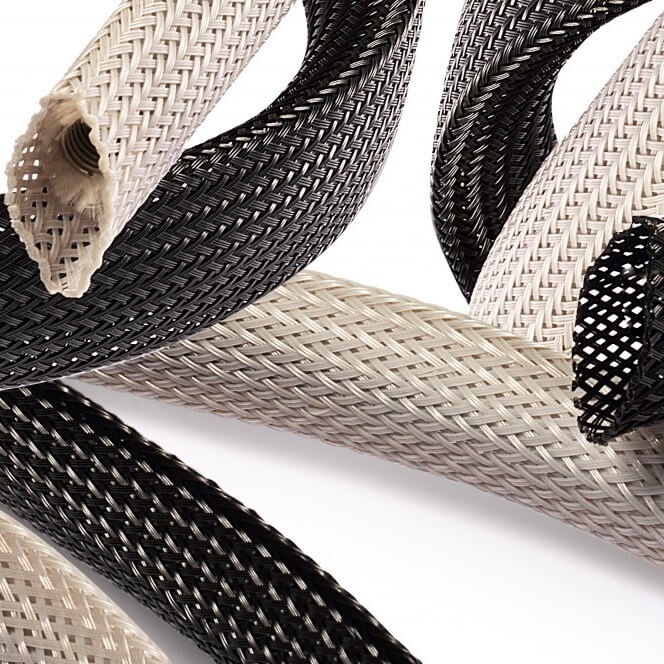How to Use Braided Sleeving to Organise & Protect Cables

Braided sleeving is a flexible, expandable woven tube that is used to organise and protect cables — whether in industrial control panels or in simple home projects. This guide shows you how to choose the right size, install it properly, and secure the ends for a clean, professional finish.
The flexible, expandable tube is made of woven strands, typically made from nylon or PET. It’s designed to wrap around cables and wire bundles and is commonly used to protect wires from abrasion, improve organisation and create a professional-looking finish.
Please note: This guide is for use within standard temperature environments. It is not intended for high-temperature or specialist automotive use.
What You’ll Need
- Scissors or hot knife tool (e.g. a bladed soldering iron designed for cutting and sealing synthetic fibres)
(Use caution — these tools reach high temperatures and should only be used on a safe surface in a well-ventilated area.) - Braided sleeving (sized appropriately and ready to cut)
- Heat shrink tubing (optional, for sealing the ends)
- Tape (optional, to help with handling and cutting)
- Lacing cord or thread (optional, for a low-profile, professional tie-off method)
- Velcro cable wraps (optional, reusable and adjustable for frequent access)
Choosing the Right Size
- Measure the cable bundle diameter you want to cover.
- Choose sleeving with a slightly smaller internal diameter — braided sleeving naturally expands to accommodate the bundle.
- If the cable has connectors, make sure the sleeving can expand enough to pass over them.
- Note: As the sleeving expands radially, it may contract in length. Allow extra length when cutting.
Cutting the Sleeving
- Best method: use a hot knife tool, which melts and seals the fibres during cutting.
- Alternative: briefly pass the cut end through a flame to seal it. Use caution to avoid burning the material or causing injury.
- If using scissors: tightly wrap tape around the area to be cut. Cut through the tape to reduce fraying.
(You can leave the tape in place for when you seal the ends.)
Plan to seal the ends immediately after cutting to maintain a tidy finish.
Installing the Sleeving
- Compress the sleeving lengthwise — this causes it to expand in diameter.
- Slide it gently over the cable bundle, working it along gradually.
- For long or tight bundles, you may need to “inch” the sleeving into place — like a Chinese finger trap.
- If you’re working around fixed connectors, make sure the sleeving is wide enough to stretch over them.
- In tight spaces, staggering the connectors can help reduce overall diameter and ease installation.
You can use tape to temporarily hold the sleeving in place during installation if needed.
Securing the Ends
- Heat shrink tubing: Slide it over each end and apply heat. This gives a professional, durable finish.
- Cable ties: Useful for quick installs or where heat tools aren’t practical.
- Velcro wraps: A reusable option for bundles that need frequent access.
- Lacing cord or thread: A traditional, low-profile method using waxed nylon or polyester cord. Common in aerospace and telecom applications.
- Tape: Can work for light-duty applications, but may degrade in heat. (Avoid tape in high-temperature environments like engine bays.)
Final Tips for a Clean Finish
- Trim off any excess sleeving once everything is in place.
- Keep the sleeving evenly distributed — avoid bunching or sagging.
- Group related cables into separate sleeves for better organisation and identification.
Summary
Braided sleeving is a practical and tidy way to protect and organise cables. With the right tools and technique, it’s easy to install — and the results can make a big difference in both durability and appearance. Whether you’re bundling wires at a workstation or cleaning up a control panel, braided sleeving helps you finish the job cleanly and professionally.




 My account
My account





